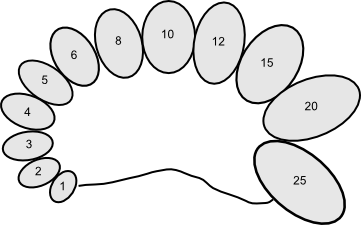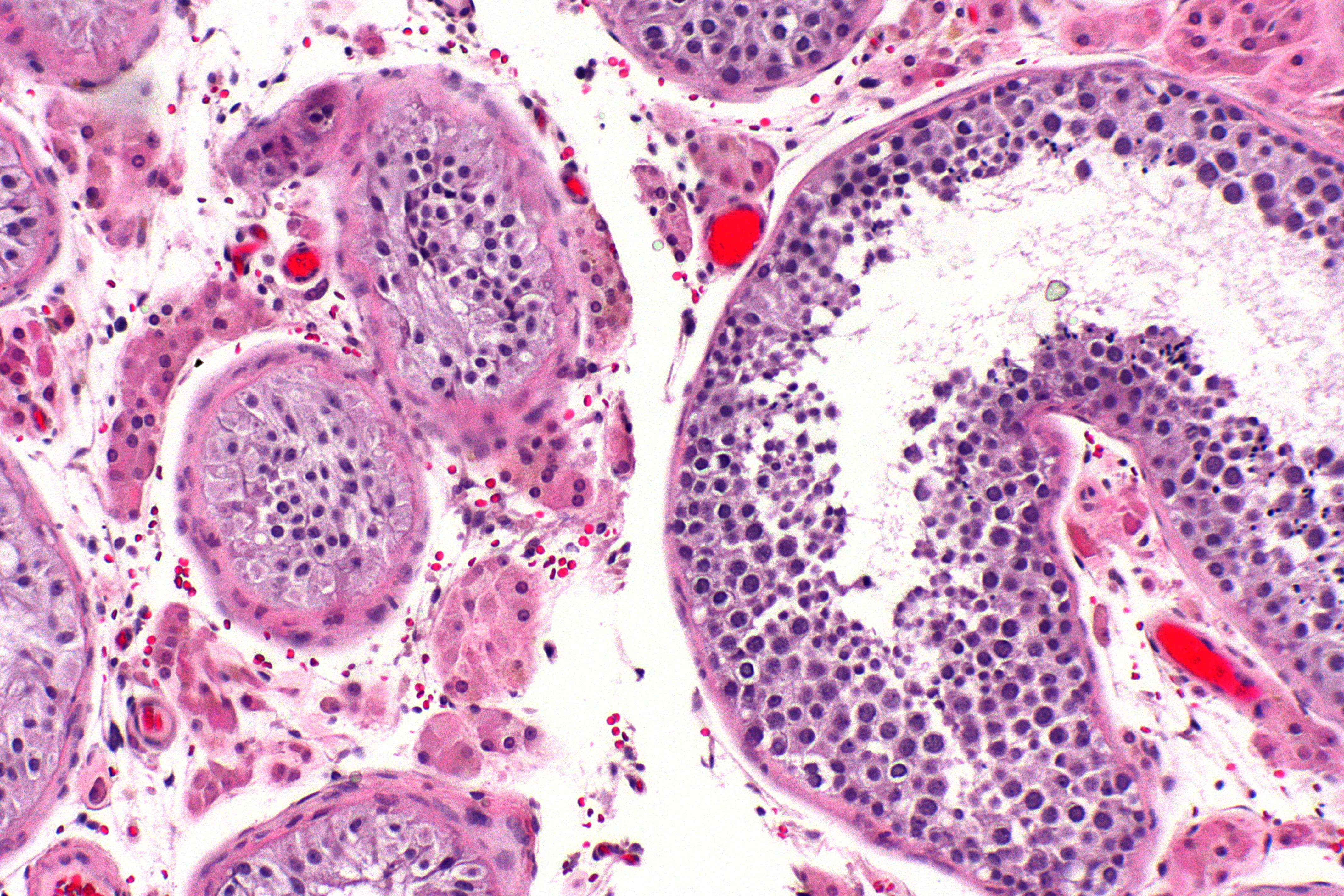|
Microorchidism
Microorchidism is a genetic disorder found in males, characterized by abnormally small testes; it is the opposite of macroorchidism, which is characterized by abnormally large testes. The condition is associated with (and often secondary to) a number of other genetic disorders, including Klinefelter's Syndrome and Prader-Willi syndrome, as well as other multiple malformation disorders. The degree of abnormality (or otherwise) of the testes can be determined by the use of an orchidometer. In addition, Microorchidism may also occur as a result of shrinkage or atrophy of the testis due to infections like mumps. It is distinct from testicular atrophy caused as a result of hormone therapy or injury. See also * Endocrine system * Orchitis Orchitis is inflammation of the testes. It can also involve swelling, pains and frequent infection, particularly of the epididymis, as in epididymitis. The term is from the Ancient Greek ὄρχις meaning "testicle"; same root as ''orchid''. S . ... [...More Info...] [...Related Items...] OR: [Wikipedia] [Google] [Baidu] |
Macroorchidism
Macroorchidism is a disorder found in males, specifically in children, where a subject has abnormally large testes. The condition is commonly inherited in connection with fragile X syndrome (FXS), which is also the second most common genetic cause of intellectual disability. The condition is also a rare sign of the McCune-Albright syndrome. The opposite of macroorchidism is called microorchidism, which is the condition of abnormally small testes. Macroorchidism is related to IGFS1 deficiency which causes an increase in the secretion of follicle stimulating hormone (FSH). There are other causes for macroorchidism such as hypothyroidism, local tumors, and aromatase deficiency. Macroorchidism can be diagnosed by measuring the testicular volume using a prader orchidometer. There is no cure for macroorchidism, however, medications are currently being tested and used to control the disorder to promote quality living. Signs and symptoms The most distinguishing physical ... [...More Info...] [...Related Items...] OR: [Wikipedia] [Google] [Baidu] |
Klinefelter's Syndrome
Klinefelter syndrome (KS), also known as 47,XXY, is an aneuploid genetic condition where a male has an additional copy of the X chromosome. The primary features are infertility and small, poorly functioning testicles. Usually, symptoms are subtle and subjects do not realize they are affected. Sometimes, symptoms are more evident and may include weaker muscles, greater height, poor motor coordination, less body hair, breast growth, and less interest in sex. Often, these symptoms are noticed only at puberty. Intelligence is usually normal, but reading difficulties and problems with speech are more common. Klinefelter syndrome occurs randomly. The extra X chromosome comes from the father and mother nearly equally. An older mother may have a slightly increased risk of a child with KS. The syndrome is defined by the presence of at least one extra X chromosome in addition to a Y chromosome yielding a total of 47 or more chromosomes rather than the usual 46. KS is diagnosed by the ... [...More Info...] [...Related Items...] OR: [Wikipedia] [Google] [Baidu] |
Genetic Disorder
A genetic disorder is a health problem caused by one or more abnormalities in the genome. It can be caused by a mutation in a single gene (monogenic) or multiple genes (polygenic) or by a chromosomal abnormality. Although polygenic disorders are the most common, the term is mostly used when discussing disorders with a single genetic cause, either in a gene or chromosome. The mutation responsible can occur spontaneously before embryonic development (a ''de novo'' mutation), or it can be Heredity, inherited from two parents who are carriers of a faulty gene (autosomal recessive inheritance) or from a parent with the disorder (autosomal dominant inheritance). When the genetic disorder is inherited from one or both parents, it is also classified as a hereditary disease. Some disorders are caused by a mutation on the X chromosome and have X-linked inheritance. Very few disorders are inherited on the Y linkage, Y chromosome or Mitochondrial disease#Causes, mitochondrial DNA (due to t ... [...More Info...] [...Related Items...] OR: [Wikipedia] [Google] [Baidu] |
Testes
A testicle or testis (plural testes) is the male reproductive gland or gonad in all bilaterians, including humans. It is homologous to the female ovary. The functions of the testes are to produce both sperm and androgens, primarily testosterone. Testosterone release is controlled by the anterior pituitary luteinizing hormone, whereas sperm production is controlled both by the anterior pituitary follicle-stimulating hormone and gonadal testosterone. Structure Appearance Males have two testicles of similar size contained within the scrotum, which is an extension of the abdominal wall. Scrotal asymmetry, in which one testicle extends farther down into the scrotum than the other, is common. This is because of the differences in the vasculature's anatomy. For 85% of men, the right testis hangs lower than the left one. Measurement and volume The volume of the testicle can be estimated by palpating it and comparing it to ellipsoids of known sizes. Another method is to use cali ... [...More Info...] [...Related Items...] OR: [Wikipedia] [Google] [Baidu] |
Orchidometer
An orchidometer (or orchiometer) is a medical instrument used to measure the volume of the testicles. The orchidometer was introduced in 1966 by Swiss pediatric endocrinologist Andrea Prader of the University of Zurich. It consists of a string of twelve numbered wooden or plastic beads of increasing size from about 1 to 25 millilitres. Doctors sometimes informally refer to them as "Prader's balls", "the medical worry beads", or the "endocrine rosary". The beads are compared with the testicles of the patient, and the volume is read off the bead which matches most closely in size. Prepubertal sizes are 1–3 ml, pubertal sizes are considered 4 ml and up and adult sizes are 15-25 ml. The orchidometer can be used to accurately determine size of testes. Discrepancy of testicular size with other parameters of maturation can be an important clue to various diseases. Small testes can indicate either primary or secondary hypogonadism. Testicular size can help distinguish between differen ... [...More Info...] [...Related Items...] OR: [Wikipedia] [Google] [Baidu] |
Atrophy
Atrophy is the partial or complete wasting away of a part of the body. Causes of atrophy include mutations (which can destroy the gene to build up the organ), poor nourishment, poor circulation, loss of hormonal support, loss of nerve supply to the target organ, excessive amount of apoptosis of cells, and disuse or lack of exercise or disease intrinsic to the tissue itself. In medical practice, hormonal and nerve inputs that maintain an organ or body part are said to have ''trophic'' effects. A diminished muscular trophic condition is designated as ''atrophy''. Atrophy is reduction in size of cell, organ or tissue, after attaining its normal mature growth. In contrast, hypoplasia is the reduction in the cellular numbers of an organ, or tissue that has not attained normal maturity. Atrophy is the general physiological process of reabsorption and breakdown of tissues, involving apoptosis. When it occurs as a result of disease or loss of trophic support because of other diseases ... [...More Info...] [...Related Items...] OR: [Wikipedia] [Google] [Baidu] |
Mumps
MUMPS ("Massachusetts General Hospital Utility Multi-Programming System"), or M, is an imperative, high-level programming language with an integrated transaction processing key–value database. It was originally developed at Massachusetts General Hospital for managing hospital laboratory information systems. MUMPS technology has since expanded as the predominant database for health information systems and electronic health records in the United States. MUMPS-based information systems run over 40% of the hospitals in the U.S., run across all of the U.S. federal hospitals and clinics, and provide health information services for over 54% of patients across the U.S. A unique feature of the MUMPS technology is its integrated database language, allowing direct, high-speed read-write access to permanent disk storage. This provides tight integration of unlimited applications within a single database, and provides extremely high performance and reliability as an online transaction pro ... [...More Info...] [...Related Items...] OR: [Wikipedia] [Google] [Baidu] |
Testicular Atrophy
Testicular atrophy is a medical condition in which one or both testicles (or "testes") diminish in size and may be accompanied by reduced testicular function. Testicular atrophy is not related to the temporary shrinkage of the surrounding scrotum, which might occur in response to cold temperature. As the testicles are involved in testosterone and sperm production, the signs and symptoms of testicular atrophy overlap with those related to infertility or low testosterone levels. In a prepubescent person with testicular atrophy, there may be underdevelopment of secondary sex characteristics (e.g. lack of penis growth). In sexually developed individuals, testicular atrophy may be accompanied with lower sex drive and increased breast tissue. Additional signs and symptoms vary and can depend on the specific cause of the testicle shrinkage. Some causes include age, alcohol use, hormone therapy, direct damage to the testicles, and infection. Diagnosis of testicular atrophy includes physica ... [...More Info...] [...Related Items...] OR: [Wikipedia] [Google] [Baidu] |
Endocrine System
The endocrine system is a messenger system comprising feedback loops of the hormones released by internal glands of an organism directly into the circulatory system, regulating distant target organs. In vertebrates, the hypothalamus is the neural control center for all endocrine systems. In humans, the major endocrine glands are the thyroid gland and the adrenal glands. The study of the endocrine system and its disorders is known as endocrinology. Glands that signal each other in sequence are often referred to as an axis, such as the hypothalamic-pituitary-adrenal axis. In addition to the specialized endocrine organs mentioned above, many other organs that are part of other body systems have secondary endocrine functions, including bone, kidneys, liver, heart and gonads. For example, the kidney secretes the endocrine hormone erythropoietin. Hormones can be amino acid complexes, steroids, eicosanoids, leukotrienes, or prostaglandins. The endocrine system can be contrasted ... [...More Info...] [...Related Items...] OR: [Wikipedia] [Google] [Baidu] |
Orchitis
Orchitis is inflammation of the testes. It can also involve swelling, pains and frequent infection, particularly of the epididymis, as in epididymitis. The term is from the Ancient Greek ὄρχις meaning "testicle"; same root as ''orchid''. Signs and symptoms Symptoms of orchitis are similar to those of testicular torsion. These can include: * hematospermia (blood in the semen) * hematuria (blood in the urine) * severe pain * visible swelling of a testicle or testicles and often the inguinal lymph nodes on the affected side. Causes Orchitis can be related to epididymitis infection that has spread to the testicles (then called "epididymo-orchitis"), sometimes caused by the sexually transmitted diseases chlamydia and gonorrhea. It has also been reported in cases of males infected with brucellosis. Orchitis can also be seen during active mumps, particularly in adolescent boys. Ischemic orchitis may result from damage to the blood vessels of the spermatic cord during inguinal h ... [...More Info...] [...Related Items...] OR: [Wikipedia] [Google] [Baidu] |
Congenital Disorders Of Male Genital Organs
A birth defect, also known as a congenital disorder, is an abnormal condition that is present at birth regardless of its cause. Birth defects may result in disabilities that may be physical, intellectual, or developmental. The disabilities can range from mild to severe. Birth defects are divided into two main types: structural disorders in which problems are seen with the shape of a body part and functional disorders in which problems exist with how a body part works. Functional disorders include metabolic and degenerative disorders. Some birth defects include both structural and functional disorders. Birth defects may result from genetic or chromosomal disorders, exposure to certain medications or chemicals, or certain infections during pregnancy. Risk factors include folate deficiency, drinking alcohol or smoking during pregnancy, poorly controlled diabetes, and a mother over the age of 35 years old. Many are believed to involve multiple factors. Birth defects may be v ... [...More Info...] [...Related Items...] OR: [Wikipedia] [Google] [Baidu] |




